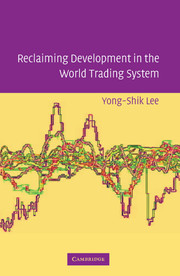Book contents
- Frontmatter
- Contents
- List of Abbreviations
- Acknowledgments
- 1 Poverty, Economic Development, and International Trade
- 2 Current Regulatory Framework for International Trade: The WTO System
- 3 Reclaiming Development: Tariff Bindings and Subsidies
- 4 Anti-Dumping and Safeguards
- 5 “Expansion” of Trade Disciplines and Development
- 6 Foreign Direct Investment and Regional Trade Liberalization
- 7 Conclusion: Putting Back the Ladder
- Epilogue
- Bibliography
- Index
5 - “Expansion” of Trade Disciplines and Development
Published online by Cambridge University Press: 18 August 2009
- Frontmatter
- Contents
- List of Abbreviations
- Acknowledgments
- 1 Poverty, Economic Development, and International Trade
- 2 Current Regulatory Framework for International Trade: The WTO System
- 3 Reclaiming Development: Tariff Bindings and Subsidies
- 4 Anti-Dumping and Safeguards
- 5 “Expansion” of Trade Disciplines and Development
- 6 Foreign Direct Investment and Regional Trade Liberalization
- 7 Conclusion: Putting Back the Ladder
- Epilogue
- Bibliography
- Index
Summary
Agriculture and Textile
Agriculture products and textiles have a particular importance for the trade of developing countries because these products tend to be the major export products for developing countries in the early stages of economic development. The lower labor costs of developing countries create a competitive advantage in labor-intensive products such as textile and some agricultural products. This advantage makes agricultural products and textiles competitive export items for developing countries and is reflected in the lower prices of these products. Therefore, it will be important to promote the export of these products from developing countries to facilitate their development, particularly in the initial development stages where developing countries do not typically have the technology to produce and export more sophisticated manufactured products.
Nonetheless, developed countries showed reluctance in bringing these products into the framework of the international trading system. First, agriculture had long been outside the purview of GATT disciplines. Significant political influence representing the interests of agricultural sectors in many developed countries has made it difficult for these developed countries to increase market access for agricultural imports. The UR went through difficulties due to the controversies over the treatment of agricultural products in the new trading system; a number of countries exporting agricultural products pushed for the full integration of agricultural products into the trading system, demanding market access as well as the elimination of production subsidies for agricultural products.
- Type
- Chapter
- Information
- Reclaiming Development in the World Trading System , pp. 107 - 140Publisher: Cambridge University PressPrint publication year: 2006



